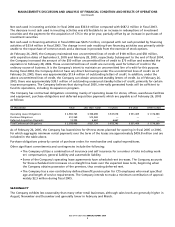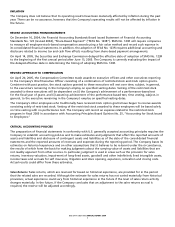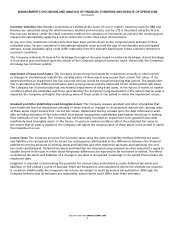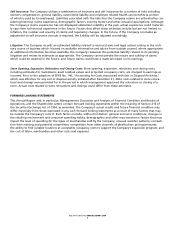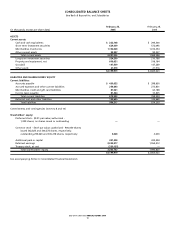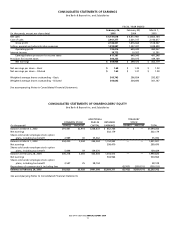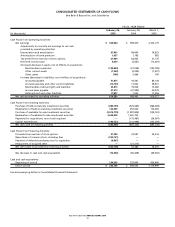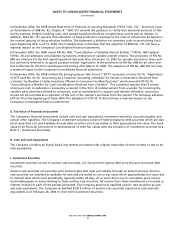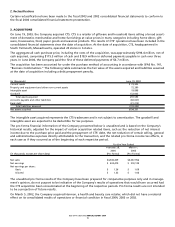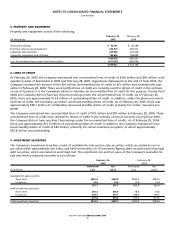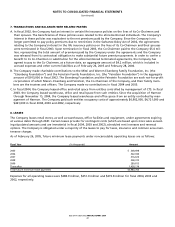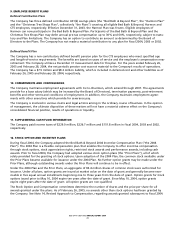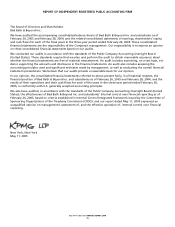Bed, Bath and Beyond 2004 Annual Report Download - page 18
Download and view the complete annual report
Please find page 18 of the 2004 Bed, Bath and Beyond annual report below. You can navigate through the pages in the report by either clicking on the pages listed below, or by using the keyword search tool below to find specific information within the annual report.
BED BATH & BEYOND ANNUAL REPORT 2004
16
N. Self Insurance
The Company utilizes a combination of insurance and self insurance for a number of risks including workers compen-
sation, general liability, automobile liability and employee related health care benefits (a portion of which is paid by
its employees). Liabilities associated with the risks that the Company retains are estimated by considering historical
claims experience, demographic factors, severity factors and other actuarial assumptions. Although the Company’s
claims experience has not displayed substantial volatility in the past, actual experience could materially vary from its
historical experience in the future. Factors that affect these estimates include but are not limited to: inflation, the
number and severity of claims and regulatory changes. In the future, if the Company concludes an adjustment to self
insurance accruals is required, the liability will be adjusted accordingly.
O. Litigation
The Company records an estimated liability related to various claims and legal actions arising in the ordinary course
of business which is based on available information and advice from outside counsel, where appropriate. As addition-
al information becomes available, the Company reassesses the potential liability related to its pending litigation and
revises its estimates as appropriate. The Company cannot predict the nature and validity of claims which could be
asserted in the future, and future claims could have a material impact on its earnings.
P. Deferred Rent
The Company accounts for scheduled rent increases contained in its leases on a straight-line basis over the term of
the lease. Historically, the Company’s method of accounting defined the beginning of the lease term as the date the
Company commenced lease payments. In fiscal 2004, due to clarification by the Office of the Chief Accountant of
the Securities and Exchange Commission, the Company changed its method of accounting to define the beginning of
the lease term as the date the Company obtained possession of the leased premises. This change in the Company’s
method of accounting did not have a material impact on the Company’s fiscal 2003 and prior consolidated financial
statements. Deferred rent amounted to $42.6 million and $32.7 million as of February 26, 2005 and February 28,
2004, respectively.
Q. Treasury Stock
In December 2004, the Board of Directors approved a $350 million share repurchase program, authorizing the repur-
chase of shares of its common stock. The Company was authorized to make repurchases from time to time in the
open market pursuant to existing rules and regulations and other parameters approved by the Board. The Company
repurchased 8,762,300 shares for approximately $350 million during fiscal 2004. The program was completed prior to
the end of the fiscal year.
R. Revenue Recognition
Sales are recognized upon purchase by customers at our retail stores or when shipped for products purchased from
our websites. The value of point of sale coupons and point of sale rebates that result in a reduction of the price paid
by the customer are recorded as a reduction of sales. Shipping and handling fees that are billed to a customer in a
sale transaction are recorded in sales. Revenues from gift cards, gift certificates and merchandise credits are recog-
nized when redeemed.
Sales returns, which are reserved for based on historical experience, are provided for in the period that the related
sales are recorded. Although the estimate for sales returns has not varied materially from historical provisions, actual
experience could vary from historical experience in the future if the level of sales return activity changes materially.
In the future, if the Company concludes that an adjustment to the sales returns accrual is required, the reserve will be
adjusted accordingly. For fiscal 2004, 2003 and 2002, the provision for sales returns was $1.2 million, $1.3 million and
$1.5 million, respectively, and no deductions were made to the reserve for sales returns. In fiscal 2003, a reserve of
approximately $0.5 million was assumed in the acquisition of CTS. As of February 26, 2005, February 28, 2004 and
March 1, 2003, the reserve for sales returns was $11.9 million, $10.7 million and $8.9 million, respectively.
NOTES TO CONSOLIDATED FINANCIAL STATEMENTS
(continued)


